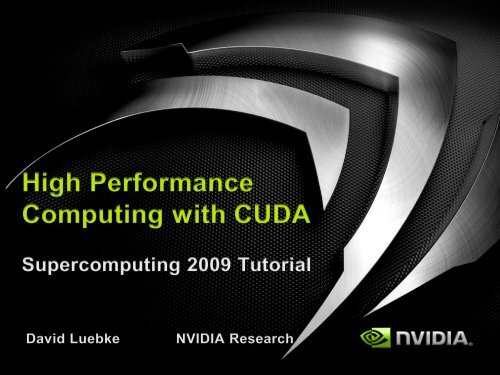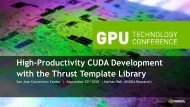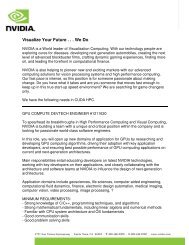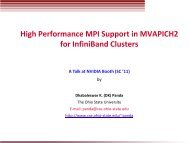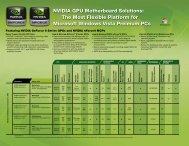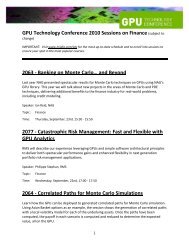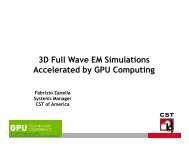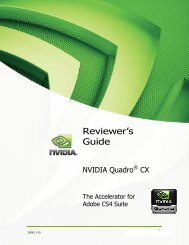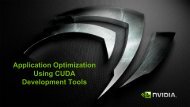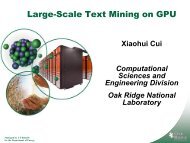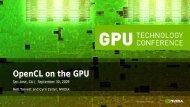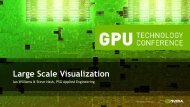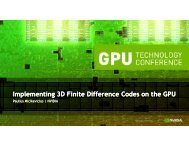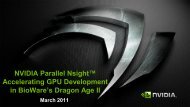High Performance Computing with CUDA, Part of Supercomputing
High Performance Computing with CUDA, Part of Supercomputing
High Performance Computing with CUDA, Part of Supercomputing
Create successful ePaper yourself
Turn your PDF publications into a flip-book with our unique Google optimized e-Paper software.
Welcome!<br />
GPUs have become a major force in HPC<br />
© NVIDIA Corporation 2009<br />
National & commercial supercomputer installations<br />
Changing the landscape <strong>with</strong> “personal supercomputing”<br />
Emerging ecosystem <strong>of</strong> tools, vendors, languages, codes<br />
GPU codenamed “Fermi” will accelerate this trend<br />
ECC, 8x double precision performance<br />
Powerful development, debugging, pr<strong>of</strong>iling tools
Tutorial topics<br />
<strong>CUDA</strong> programming model<br />
Tools, languages, and libraries for GPU computing<br />
Advanced <strong>CUDA</strong>: optimization, irregular parallelism<br />
Case studies:<br />
CFD<br />
© NVIDIA Corporation 2009<br />
Seismic processing<br />
QCD<br />
Molecular dynamics
GFLOPS<br />
Motivation<br />
CPU<br />
Intel Core i7 965<br />
4 cores<br />
102 GFLOPS<br />
Fact:<br />
nobody cares about theoretical peak<br />
GPU<br />
NVIDIA TESLA C1060<br />
240 cores<br />
936 GFLOPS<br />
GPU<br />
Challenge:<br />
harness GPU power for real application performance<br />
CPU
Motivation: Accelerating Insight<br />
4.6 Days<br />
27 Minutes<br />
© NVIDIA Corporation 2009<br />
2.7 Days<br />
30 Minutes<br />
8 Hours<br />
13 Minutes<br />
CPU Only Heterogeneous <strong>with</strong> Tesla GPU<br />
3 Hours<br />
16 Minutes
<strong>CUDA</strong> is everywhere<br />
Over 270 universities teach <strong>CUDA</strong><br />
Over 2500 research papers<br />
180 Million <strong>CUDA</strong> GPUs<br />
100,000 active developers<br />
<strong>CUDA</strong> powered<br />
supercomputers<br />
639 <strong>CUDA</strong> applications<br />
and counting
NVIDIA GPUs at <strong>Supercomputing</strong> 09<br />
© NVIDIA Corporation 2009<br />
12% <strong>of</strong> papers use NVIDIA GPUs<br />
GPU-based Paper by Hamada up for Gordon Bell<br />
Jack Dongarra, ORNL, Sandia, Los Alamos, Matsuoka<br />
speaking at NVIDIA Booth<br />
20+ System Providers are demoing Tesla GPUs<br />
HP, Dell, Cray, Bull, Appro, NEC, SGI, Sun, SuperMicro, Penguin, Colfax, Silicon Mechanics, Scalable, Verari, Tycrid,<br />
Mellanox, Creative Consultants, Microway, ACE, TeamHPC<br />
11+ S<strong>of</strong>tware Providers building on <strong>CUDA</strong> GPUs<br />
Micros<strong>of</strong>t, The Mathworks, Allinea, TotalView, Accelereyes, EM Photonics, Tech-X, CAPS, Platform <strong>Computing</strong>, NAG, PGI, Wolfram<br />
LANL, ORNL, SLAC, TACC, GaTech, HPC Advisory Council, Khronos<br />
Group showing GPU <strong>Computing</strong> Demos
GPUs in high-performance computing<br />
© NVIDIA Corporation 2009
Products<br />
<strong>CUDA</strong> is in products from laptops to supercomputers<br />
© NVIDIA Corporation 2009<br />
`
Emerging HPC Products<br />
New class <strong>of</strong> hybrid GPU-CPU servers<br />
SuperMicro 1U<br />
GPU Server<br />
© NVIDIA Corporation 2009<br />
2 Tesla<br />
M1060 GPUs<br />
Upto 18 Tesla<br />
M1060 GPUs<br />
Bull Bullx<br />
Blade Enclosure
Tutorial goals<br />
A detailed introduction to high performance<br />
computing <strong>with</strong> <strong>CUDA</strong><br />
We emphasize:<br />
© NVIDIA Corporation 2009<br />
Understanding the architecture & programming model<br />
Core computational building blocks<br />
Libraries and tools<br />
Optimization strategy & tactics<br />
Case studies to bring it all together
Tutorial prerequisites<br />
Tutorial intended to be accessible to any<br />
savvy computer or computational scientist<br />
Helpful but not required: familiarity <strong>with</strong><br />
data-parallel algorithms and programming<br />
Target audience: HPC practitioners using or<br />
considering <strong>CUDA</strong><br />
© NVIDIA Corporation 2009
Speakers:<br />
In order <strong>of</strong> appearance:<br />
© NVIDIA Corporation 2009<br />
David Luebke NVIDIA<br />
Ian Buck NVIDIA<br />
Jonathan Cohen NVIDIA<br />
John Owens University <strong>of</strong> California Davis<br />
Paulius Micikevicius NVIDIA<br />
Scott Morton Hess<br />
John Stone University <strong>of</strong> Illinois Urbana-Champaign<br />
Mike Clark Harvard
Schedule<br />
8:30 Introduction<br />
Welcome, overview, <strong>CUDA</strong> basics<br />
9:00 <strong>CUDA</strong> programming environments<br />
10:00 Break<br />
Toolchain, languages, wrappers<br />
10:30 <strong>CUDA</strong> libraries & tools<br />
MAGMA & CULA, Thrust, CuFFT, CuBLAS…<br />
<strong>CUDA</strong>-gdb, Visual Pr<strong>of</strong>iler, codename “Nexus”…<br />
Luebke<br />
Buck<br />
Cohen
Schedule<br />
11:15 Optimizing GPU performance<br />
12:00 Lunch<br />
1:30 Optimizing CPU-GPU performance<br />
1:45 Irregular algorithms & data structures<br />
Sparse linear algebra, tree traversal, hash tables<br />
Micikevicius<br />
Micikevicius<br />
Owens
Schedule: case studies<br />
2:30 Molecular modeling<br />
3:00 Break<br />
3:30 Seismic imaging<br />
4:00 Computational fluid dynamics<br />
5:00 Quantum Chromodynamics<br />
5:00 Wrap!<br />
Stone<br />
Morton<br />
Cohen<br />
Clark
<strong>CUDA</strong> In One Slide<br />
Thread<br />
© NVIDIA Corporation 2009<br />
per-thread<br />
local memory<br />
Global barrier<br />
Local barrier<br />
Kernel foo()<br />
. . .<br />
Kernel bar()<br />
. . .<br />
Block<br />
per-device<br />
global<br />
memory<br />
per-block<br />
shared<br />
memory
<strong>CUDA</strong> C Example<br />
void saxpy_serial(int n, float a, float *x, float *y)<br />
{<br />
for (int i = 0; i < n; ++i)<br />
y[i] = a*x[i] + y[i];<br />
}<br />
// Invoke serial SAXPY kernel<br />
saxpy_serial(n, 2.0, x, y);<br />
__global__ void saxpy_parallel(int n, float a, float *x, float *y)<br />
{<br />
int i = blockIdx.x*blockDim.x + threadIdx.x;<br />
if (i < n) y[i] = a*x[i] + y[i];<br />
}<br />
// Invoke parallel SAXPY kernel <strong>with</strong> 256 threads/block<br />
int nblocks = (n + 255) / 256;<br />
saxpy_parallel(n, 2.0, x, y);<br />
Serial C Code<br />
Parallel C Code
Heterogeneous Programming<br />
Use the right processor for the right job<br />
© NVIDIA Corporation 2009<br />
Serial Code<br />
Parallel Kernel<br />
foo>(args);<br />
Serial Code<br />
Parallel Kernel<br />
bar>(args);<br />
. . .<br />
. . .
Example: Parallel Reduction<br />
Summing up a sequence <strong>with</strong> 1 thread:<br />
int sum = 0;<br />
© NVIDIA Corporation 2009<br />
for(int i=0; i
Example: Parallel Reduction<br />
Summing up a sequence <strong>with</strong> 1 thread:<br />
int sum = 0;<br />
© NVIDIA Corporation 2009<br />
for(int i=0; i
Parallel Reduction for 1 Block<br />
// INPUT: Thread i holds value x_i<br />
int i = threadIdx.x;<br />
__shared__ int sum[blocksize];<br />
// One thread per element<br />
sum[i] = x_i; __syncthreads();<br />
for(int bit=blocksize/2; bit>0; bit/=2)<br />
{<br />
}<br />
int t=sum[i]+sum[i^bit]; __syncthreads();<br />
sum[i]=t; __syncthreads();<br />
// OUTPUT: Every thread now holds sum in sum[i]<br />
© NVIDIA Corporation 2009
Next-Gen GPU: codename Fermi<br />
© NVIDIA Corporation 2009<br />
3 billion transistors<br />
512 <strong>CUDA</strong> cores<br />
~2x the memory bandwidth<br />
L1 and L2 caches<br />
8x the peak fp64 performance<br />
ECC<br />
C++
Time<br />
Hardware Thread Scheduling<br />
Concurrent kernel execution + faster context switch<br />
Kernel 1 Kernel 1 Kernel 2<br />
Kernel 2<br />
Kernel 4<br />
Kernel 3<br />
Kernel 2 Kernel 2<br />
Kernel 3<br />
Kernel 5<br />
Serial Kernel Execution Parallel Kernel Execution<br />
nel<br />
Kernel 5<br />
Ker<br />
4
More Fermi Goodness<br />
Unified 40-bit address space for local, shared, global<br />
Configurable 64K L1$ / shared memory<br />
10x faster atomics<br />
Dual DMA engines for CPU�� GPU transfers<br />
IEEE 754-2008: Fused Multiply-Add (FMA) for SP, DP
Conclusion<br />
GPUs are massively parallel manycore computers<br />
© NVIDIA Corporation 2009<br />
Ubiquitous - most successful parallel processor in history<br />
Useful - users achieve huge speedups on real problems<br />
<strong>CUDA</strong> is a powerful parallel programming model<br />
Heterogeneous - mixed serial-parallel programming<br />
Scalable - hierarchical thread execution model<br />
Accessible – many languages, OSs, vendors<br />
They provide tremendous scope for innovation
At the NVIDIA booth (#2365)<br />
GPU <strong>Computing</strong> Poster Showcase (Monday 7pm - 9pm)<br />
Demo <strong>of</strong> Next Generation “Fermi” Architecture<br />
3D Internet Demo – Cloud <strong>Computing</strong> <strong>with</strong> NVIDIA RealityServer<br />
NVIDIA Theater, including talks by:<br />
Jack Dongarra (Univ <strong>of</strong> Tenn) Bill Dally (NVIDIA)<br />
Jeff Vetter (Oak Ridge Nat’l Lab) Satoshi Matsuoka (Tokyo Institute <strong>of</strong> Tech)<br />
Pat McCormick (Los Alamos Nat’l Lab) Paul Crozier (Sandia Nat’l Lab)<br />
Mike Clark (Harvard Univ)<br />
Ross Walker (San Diego <strong>Supercomputing</strong> Center / UCSD)


